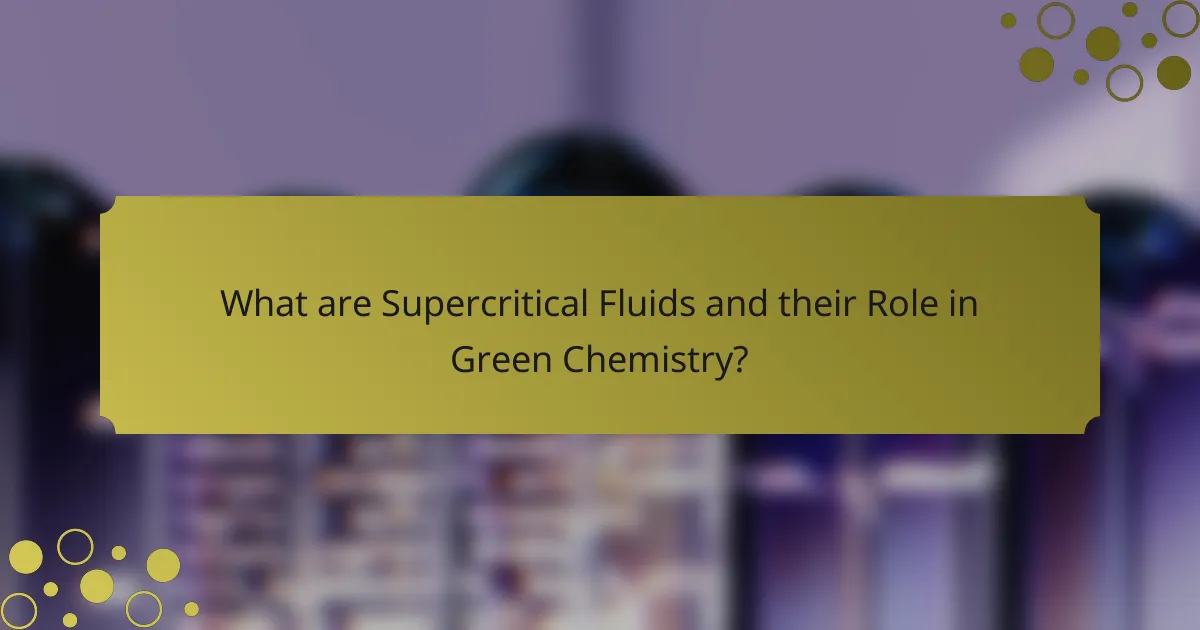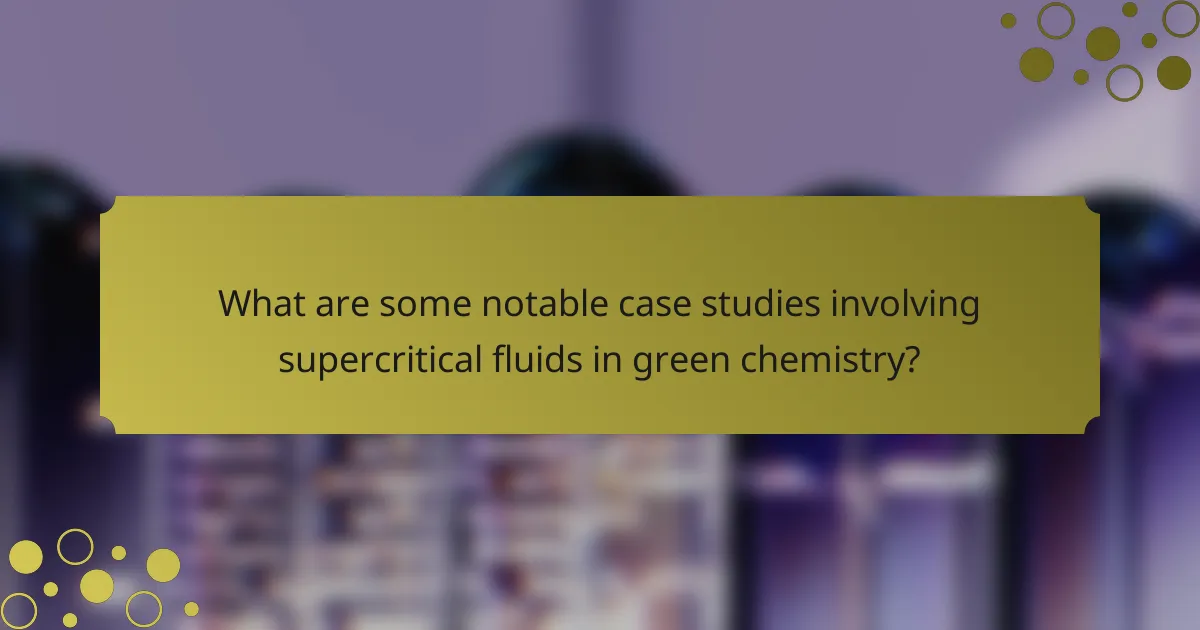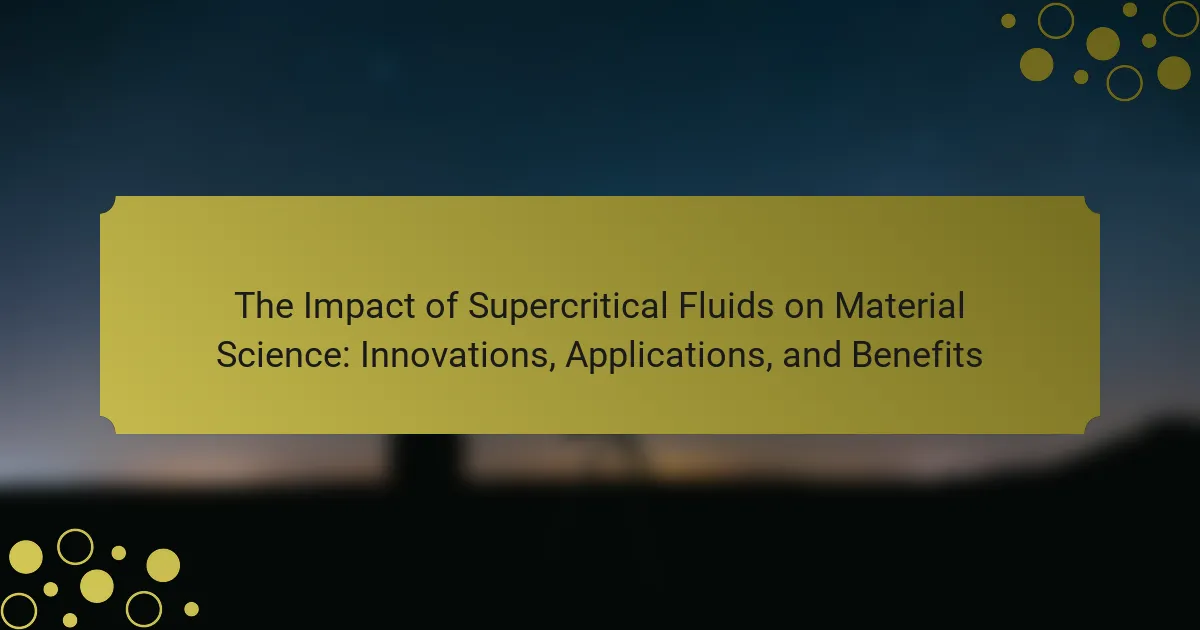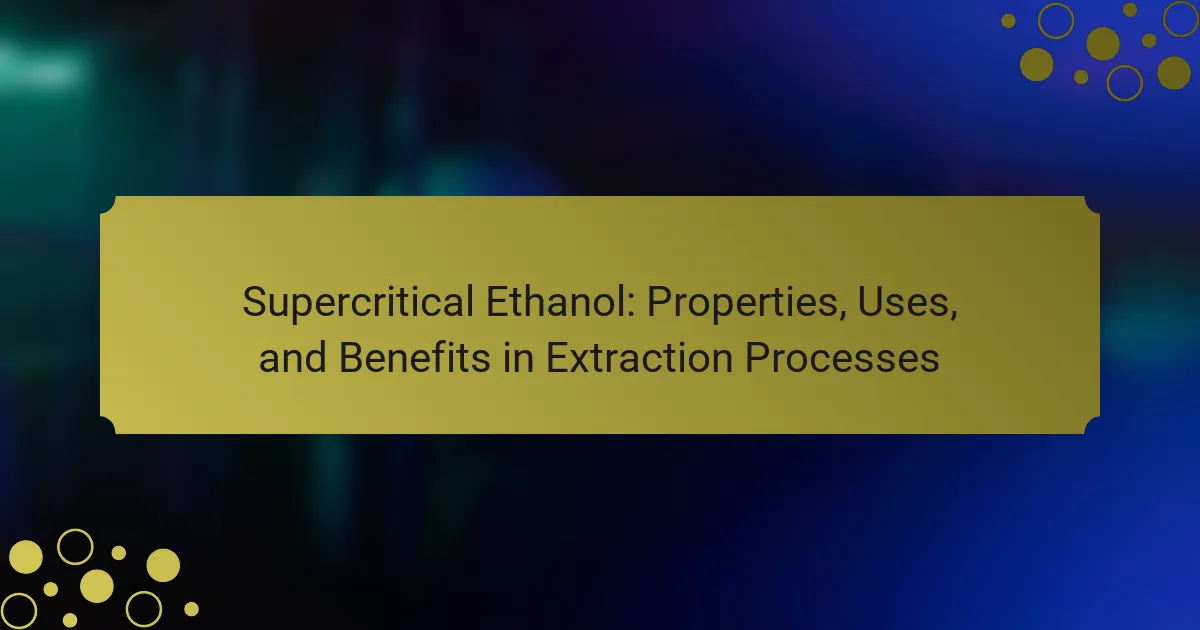Supercritical fluids are substances that exist above their critical temperature and pressure, displaying characteristics of both liquids and gases. In the context of green chemistry, these fluids, particularly supercritical carbon dioxide (scCO2), are utilized as eco-friendly solvents for various chemical processes, including the extraction of natural products and the facilitation of chemical reactions. This article explores the principles and advantages of supercritical fluids, highlighting their applications across industries such as pharmaceuticals, food processing, and environmental remediation. Notable case studies demonstrate their effectiveness in extracting essential oils and producing biodiesel, showcasing the potential for reduced waste and energy consumption in chemical manufacturing.

What are Supercritical Fluids and their Role in Green Chemistry?
Supercritical fluids are substances at a temperature and pressure above their critical points, exhibiting properties of both liquids and gases. In green chemistry, they serve as environmentally friendly solvents for various chemical processes. Supercritical carbon dioxide (scCO2) is the most widely used supercritical fluid due to its low toxicity and ability to dissolve a wide range of organic compounds. This property allows for efficient extraction of natural products, reducing the need for harmful organic solvents. Supercritical fluids also facilitate chemical reactions by providing a medium that enhances mass transfer and reaction rates. Research indicates that using supercritical fluids can significantly reduce waste and energy consumption in chemical manufacturing. For example, the use of scCO2 in the extraction of essential oils has been shown to yield higher purity and lower environmental impact compared to traditional methods.
How are supercritical fluids defined in the context of green chemistry?
Supercritical fluids are defined as substances at a temperature and pressure above their critical points. In this state, they exhibit properties of both liquids and gases. Supercritical fluids can dissolve materials like a liquid while diffusing through solids like a gas. This unique behavior makes them valuable in green chemistry applications. They can replace hazardous solvents, reducing environmental impact. Research shows that supercritical carbon dioxide is commonly used for extraction processes. Its low toxicity and ability to be recycled enhance sustainability. Supercritical fluids contribute to more efficient and environmentally friendly chemical processes.
What are the key characteristics of supercritical fluids?
Supercritical fluids are substances at a temperature and pressure above their critical points. They exhibit unique properties that combine gas and liquid characteristics. Supercritical fluids have high diffusivity, allowing them to penetrate materials easily. They possess low viscosity, which enhances their ability to dissolve various solutes. Additionally, they have adjustable solvent power, which can be fine-tuned by changing temperature and pressure. Supercritical fluids also exhibit high density, contributing to their effective extraction capabilities. These characteristics make them valuable in processes such as extraction, reaction media, and material processing in green chemistry.
Why are supercritical fluids considered environmentally friendly?
Supercritical fluids are considered environmentally friendly because they can replace toxic solvents in various processes. They often have low toxicity and can reduce hazardous waste. Supercritical carbon dioxide, for example, is non-flammable and non-toxic. This fluid can effectively extract compounds without harmful residues. Additionally, supercritical fluids operate at lower temperatures, which saves energy. Their use minimizes the environmental impact of chemical processes. Studies have shown that using supercritical fluids can lead to higher yields with fewer by-products. This aligns with green chemistry principles, promoting sustainability and safety.
What principles govern the use of supercritical fluids in green chemistry?
Supercritical fluids in green chemistry are governed by principles that emphasize sustainability and efficiency. These principles include the reduction of hazardous solvents, minimized energy consumption, and enhanced selectivity in chemical processes. Supercritical fluids, such as carbon dioxide, act as solvents that can dissolve a wide range of substances without the environmental impact of traditional solvents. Their tunable properties allow for precise control over reaction conditions. This leads to higher reaction rates and yields. The use of supercritical fluids reduces waste generation, aligning with the principles of green chemistry. Research has shown that using supercritical CO2 can replace organic solvents in various applications, demonstrating its effectiveness and environmental benefits.
How do temperature and pressure affect supercritical fluids?
Temperature and pressure significantly influence the properties of supercritical fluids. Supercritical fluids exist above their critical temperature and pressure, where distinct liquid and gas phases do not exist. Increasing temperature typically leads to lower density and higher diffusivity in supercritical fluids. Conversely, increasing pressure raises the density and solvation power of these fluids. For instance, carbon dioxide becomes a supercritical fluid at 31.1°C and 73.8 atm. At these conditions, it can effectively dissolve non-polar compounds, enhancing extraction processes. This behavior is critical in applications such as green chemistry, where supercritical fluids replace toxic solvents.
What are the thermodynamic properties of supercritical fluids?
Supercritical fluids exhibit unique thermodynamic properties that distinguish them from gases and liquids. They possess a density similar to liquids while maintaining the viscosity of gases. Supercritical fluids can diffuse through solids like gases, allowing for enhanced mass transfer. Their ability to dissolve a wide range of substances makes them effective solvents. Supercritical fluids also have tunable properties, which can be adjusted by altering pressure and temperature. The critical point defines the transition between liquid and gas phases. Above this point, distinct phase boundaries disappear. These properties enable supercritical fluids to play a significant role in various applications, particularly in green chemistry.
What advantages do supercritical fluids offer in green chemistry applications?
Supercritical fluids offer several advantages in green chemistry applications. They act as environmentally friendly solvents, reducing the need for hazardous organic solvents. Their tunable properties allow for optimal extraction and reaction conditions. Supercritical fluids can dissolve a wide range of compounds, enhancing reaction efficiency. They facilitate faster reaction rates and improved product yields. Additionally, supercritical fluids can be easily removed from products, minimizing waste. Studies show that using supercritical CO2 can significantly lower energy consumption in extraction processes. These benefits align with green chemistry principles, promoting sustainability and reducing environmental impact.
How do supercritical fluids enhance reaction efficiency?
Supercritical fluids enhance reaction efficiency by providing unique solvent properties. They possess both gas-like and liquid-like characteristics. This duality allows for improved mass transfer and solubility of reactants. Enhanced solubility increases the concentration of reactants in the reaction medium. Additionally, supercritical fluids can facilitate faster reaction rates due to increased kinetic energy. The ability to tune temperature and pressure also allows for optimal reaction conditions. Studies show that reactions in supercritical fluids can lead to higher yields and selectivity. For instance, supercritical carbon dioxide has been successfully used in various organic reactions, demonstrating significant efficiency improvements.
What are the economic benefits of using supercritical fluids?
Supercritical fluids offer significant economic benefits in various industries. They enhance extraction processes, leading to higher yields of valuable compounds. This efficiency reduces the amount of raw materials needed. The use of supercritical fluids often lowers energy consumption compared to traditional methods. For instance, they operate at lower temperatures and pressures, resulting in cost savings. Additionally, supercritical fluids can reduce waste production, minimizing disposal costs. Their ability to replace toxic solvents also lowers regulatory compliance costs. Overall, these factors contribute to increased profitability and sustainability in industrial applications.

What are the practical applications of supercritical fluids in various industries?
Supercritical fluids have practical applications across various industries, including pharmaceuticals, food processing, and environmental remediation. In pharmaceuticals, they are used for drug extraction and formulation due to their ability to dissolve a wide range of compounds. Supercritical carbon dioxide is particularly effective for extracting active ingredients from plants. In food processing, supercritical fluids aid in the decaffeination of coffee and the extraction of natural flavors while preserving quality. The environmental sector utilizes supercritical fluids for cleaning contaminated soils and groundwater. Their high diffusivity and low viscosity enhance the efficiency of extraction processes. Additionally, supercritical fluids serve as solvents in chemical reactions, improving reaction rates and yields. The versatility of supercritical fluids makes them valuable in promoting sustainable practices across these industries.
How are supercritical fluids utilized in extraction processes?
Supercritical fluids are utilized in extraction processes as efficient solvents for isolating compounds. They possess unique properties that enhance solubility and mass transfer. Supercritical carbon dioxide is commonly used due to its low toxicity and ability to selectively extract desired substances. The extraction occurs at high pressure and temperature, allowing the fluid to penetrate materials effectively. This method is applied in food, pharmaceuticals, and natural product industries. Studies show that supercritical fluid extraction can yield higher quality extracts compared to traditional methods. For instance, it reduces the need for harmful organic solvents, aligning with green chemistry principles.
What are the advantages of supercritical fluid extraction over traditional methods?
Supercritical fluid extraction (SFE) offers several advantages over traditional extraction methods. SFE uses supercritical fluids, typically carbon dioxide, which have unique properties. These fluids can dissolve a wide range of compounds, providing efficient extraction.
SFE operates at lower temperatures compared to traditional methods, preserving heat-sensitive compounds. This reduces the risk of thermal degradation. Additionally, SFE is more environmentally friendly. It often uses non-toxic solvents and generates less waste.
The process is also more selective. It can target specific compounds, leading to higher purity in the extracted material. Furthermore, SFE allows for easier solvent removal. The supercritical fluid can be depressurized to recover the extracted compounds without the need for extensive purification steps.
Overall, these advantages make SFE a preferred choice in many applications, particularly in the food and pharmaceutical industries.
Which natural products can be effectively extracted using supercritical fluids?
Supercritical fluids can effectively extract various natural products. Common examples include essential oils, such as those from lavender and eucalyptus. Additionally, supercritical fluids are used to extract caffeine from coffee beans. They are also effective for extracting carotenoids from plants. Furthermore, supercritical CO2 is utilized for extracting lipids from algae. These methods are efficient and environmentally friendly, aligning with green chemistry principles. Studies show that supercritical extraction can yield higher purity levels compared to traditional methods.
In what ways do supercritical fluids contribute to sustainable manufacturing?
Supercritical fluids contribute to sustainable manufacturing by reducing the need for harmful solvents. They offer efficient extraction processes, minimizing waste generation. Supercritical CO2, for example, is non-toxic and recyclable. This fluid can dissolve a wide range of materials, enhancing process efficiency. Additionally, supercritical fluids operate at lower temperatures, saving energy. They also enable the synthesis of materials with fewer byproducts. Studies show that using supercritical fluids can decrease environmental impact significantly. Overall, their unique properties promote greener manufacturing practices.
How can supercritical fluids be used in the production of biofuels?
Supercritical fluids can be used in the production of biofuels through a process called supercritical fluid extraction. This technique utilizes supercritical carbon dioxide or other solvents to extract oils from biomass. The supercritical state allows the solvent to have unique properties, enhancing solubility and mass transfer.
In this process, supercritical fluids can dissolve non-polar compounds effectively. This capability is particularly useful for extracting lipids from algae or oilseeds. The extraction process is efficient and results in high yields of biofuel precursors.
Studies have shown that using supercritical fluids reduces the need for harmful organic solvents. For example, research indicates that supercritical CO2 extraction can produce high-quality biodiesel from various feedstocks. The method also operates at lower temperatures, preserving the integrity of sensitive compounds.
Overall, supercritical fluids offer a sustainable and efficient approach to biofuel production. Their unique properties facilitate the extraction of valuable components while minimizing environmental impact.
What role do supercritical fluids play in the development of green solvents?
Supercritical fluids serve as environmentally friendly solvents in green chemistry. They possess unique properties, such as low viscosity and high diffusivity. These characteristics enhance mass transfer and solubility compared to traditional solvents. Supercritical carbon dioxide is a common example, being non-toxic and easily removed from products. Their use reduces harmful solvent emissions and waste. Research shows that supercritical fluids can replace organic solvents in various extraction processes. This transition supports sustainable practices in industries like pharmaceuticals and food processing. Overall, supercritical fluids significantly contribute to the development of green solvents by promoting eco-friendly alternatives.

What are some notable case studies involving supercritical fluids in green chemistry?
Notable case studies involving supercritical fluids in green chemistry include the extraction of essential oils and the synthesis of biodiesel. One case study demonstrated the use of supercritical CO2 for extracting essential oils from plants. This method resulted in higher yields and preserved the oil’s quality compared to traditional methods. Another case study focused on biodiesel production using supercritical methanol. This process allowed for the conversion of various feedstocks into biodiesel with minimal waste and energy consumption. These studies highlight the efficiency and environmental benefits of using supercritical fluids in green chemistry applications.
What successful applications of supercritical fluids have been documented?
Supercritical fluids have documented successful applications in various fields. They are extensively used in the extraction of natural products, such as essential oils and phytochemicals. Supercritical carbon dioxide (CO2) is a popular solvent due to its non-toxic nature and effectiveness.
In the food industry, supercritical fluids aid in decaffeination processes without compromising flavor. In pharmaceuticals, they facilitate the formulation of drugs by improving solubility and bioavailability. Additionally, supercritical fluids are employed in polymer processing to create lightweight materials with enhanced properties.
Research has shown that supercritical fluid technology reduces hazardous waste compared to traditional methods. Studies indicate that this approach can lead to more efficient and sustainable production processes across multiple sectors.
What lessons can be learned from the case studies of supercritical fluid usage?
Case studies of supercritical fluid usage reveal several key lessons. Supercritical fluids can enhance extraction efficiency. This efficiency often leads to higher yields of desired compounds. The use of supercritical fluids can reduce the need for organic solvents. This reduction contributes to a more environmentally friendly process. Additionally, supercritical fluids allow for selective extraction. This selectivity can improve product purity. Case studies also highlight the importance of process optimization. Optimizing parameters such as temperature and pressure is crucial for success. Overall, these lessons underscore the versatility and sustainability of supercritical fluid applications in green chemistry.
How do these case studies illustrate the benefits and challenges of supercritical fluids?
Case studies illustrate the benefits and challenges of supercritical fluids by providing real-world examples. For instance, in extraction processes, supercritical CO2 demonstrates high efficiency in extracting essential oils. This method minimizes solvent use and reduces environmental impact. However, challenges include the need for high pressure and temperature, which can increase operational costs. Another case study on supercritical fluid chromatography shows improved separation of compounds. This technique enhances resolution and speed. Yet, it requires specialized equipment and expertise, posing barriers for smaller laboratories. Overall, these case studies highlight both the practical advantages and the technical challenges associated with supercritical fluid applications.
What challenges have been encountered in implementing supercritical fluid technologies?
The challenges encountered in implementing supercritical fluid technologies include high equipment costs and complex operational requirements. These technologies often require specialized machinery that can withstand extreme pressures and temperatures. Additionally, there is a need for skilled personnel to operate and maintain these systems effectively. The scalability of supercritical fluid processes can also be an issue, as adapting them for larger production volumes is often difficult. Furthermore, the limited availability of suitable solvents for certain applications poses a challenge. Lastly, regulatory hurdles may arise due to safety and environmental concerns associated with high-pressure systems.
How have researchers addressed these challenges in their case studies?
Researchers have addressed challenges in using supercritical fluids in green chemistry by developing innovative extraction techniques. They have optimized parameters like temperature and pressure to enhance efficiency. Case studies demonstrate improved yields in extracting bioactive compounds. Researchers also focused on reducing solvent usage, which minimizes environmental impact. They employed supercritical carbon dioxide as a solvent, proving effective in various applications. Studies revealed that this method reduces toxic waste compared to traditional solvents. Researchers published findings in journals like “Green Chemistry,” showcasing successful applications. Overall, these efforts highlight advancements in sustainable practices within green chemistry.
What best practices can be adopted when working with supercritical fluids in green chemistry?
Best practices for working with supercritical fluids in green chemistry include ensuring proper safety protocols. This involves using appropriate personal protective equipment (PPE) to mitigate risks. Maintaining equipment integrity is crucial for preventing leaks and ensuring operational safety. It is also important to optimize process parameters for efficiency, such as temperature and pressure settings. Using renewable or non-toxic solvents enhances the sustainability of the process. Regular training for personnel on supercritical fluid handling is essential. Monitoring environmental impact helps in assessing the ecological footprint of processes. Finally, documenting procedures and results supports reproducibility and continuous improvement.
Supercritical fluids, particularly supercritical carbon dioxide (scCO2), are substances that exist above their critical temperature and pressure, exhibiting properties of both liquids and gases. They play a crucial role in green chemistry by serving as environmentally friendly solvents that enhance extraction processes, reduce hazardous waste, and promote energy efficiency. This article explores the principles governing supercritical fluids, their advantages in various applications, and notable case studies demonstrating their effectiveness in industries such as pharmaceuticals and food processing. Additionally, it addresses the challenges faced in implementing supercritical fluid technologies and outlines best practices for optimizing their use in sustainable manufacturing.



